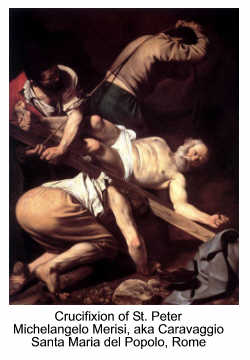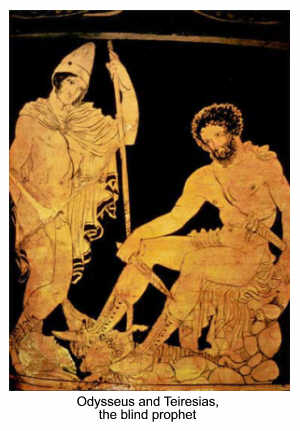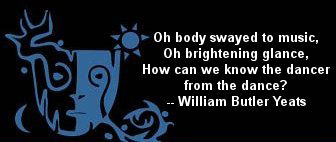|

Peter, Son of Jonah
© 2007 Jay D'Ambrosio, M.A., used with permission
 The mind is its own place, and in itself, The mind is its own place, and in itself,
can make heaven of Hell, and a hell of Heaven. — John Milton
I tell you, Peter, before the rooster crows today, you will deny three times that you know me. — Luke 22:34
I cry out to God
Seeking only his decision
Gabriel stands and confirms
I've created my own prison
Creed
Peter was the fiery fisherman who followed Jesus with a passion. He wore his heart on his sleeves and frequently said things he later regretted. What some tend to forget is that he was also known as Simon, son of Jonah. What's in a name? Maybe more than we think. Remember that the story of Christ's death, burial, and resurrection three days later was often compared to the story of Jonah who endured three days in the belly of the whale, a symbolic death. While his father and the Jonah of biblical epic were two entirely different men, we will see that there is a metaphorical similiarity between Peter and Jonah.
In the story of Jesus' life, he was physically crucified, bearing the bitter agony of the sins of the world upon himself. He was nailed to the cross with three nails, one through each hand and one through both feet ... keep that in mind. He died, was sealed in the tomb, and rose again on the third day, unveiling a new hope for all humanity. While Jesus was traveling his dark path, Peter too was experiencing a crucifixion on the level of the soul, a death and entombment of his own making.
When Jesus was handed over to the authorities, Peter waited outside to hear any news of his master's fate:
 Then seizing him, they led him away and took him into the house of the high priest. Peter followed at a distance. But when they had kindled a fire in the middle of the courtyard and had sat down together, Peter sat down with them. A servant girl saw him seated there in the firelight. She looked closely at him and said, "This man was with him." But he denied it. "Woman, I don't know him," he said. — Luke 22:54-57 Then seizing him, they led him away and took him into the house of the high priest. Peter followed at a distance. But when they had kindled a fire in the middle of the courtyard and had sat down together, Peter sat down with them. A servant girl saw him seated there in the firelight. She looked closely at him and said, "This man was with him." But he denied it. "Woman, I don't know him," he said. — Luke 22:54-57
Peter's heart had just been pierced by the first nail:
A little later someone else saw him and said, "You also are one of them." "Man, I am not!" Peter replied. — Luke 22:58
The second nail was pounded through:
About an hour later another asserted, "Certainly this fellow was with him, for he is a Galilean." Peter replied, "Man, I don't know what you're talking about!" Just as he was speaking, the rooster crowed. The Lord turned and looked straight at Peter. Then Peter remembered the word the Lord had spoken to him: "Before the rooster crows today, you will disown me three times." And he went outside and wept bitterly. — Luke 22:59-62
The third nail impaled his heart with such force that Peter wept aloud. Not only had he denied his master, but Jesus actually makes eye contact with him as he does it. The eyes are the windows of the soul. The two souls met at the moment of betrayal. Peter was crucified, perhaps not literally but his heart knew the truth. His Lord was crucified on Golgotha with criminals, writhing in agony. Peter was on the streets with criminals, writhing from inner agony. He had disowned his master and friend in his hour of greatest need. He had lost hope, friendship, and his courage in three hammer blows. Just like Jonah, he had been swallowed by the whale that had been lurking in the depths of his soul.
Imagine the next morning and the morning after that. The crowing of roosters must have felt like salt poured into searing wounds, again reminding him of his failure and denial. He was in Hell, the Abyss, the belly of the whale. There in the depths, Peter was stung by the acid of his failure. He tasted the bile of his betrayal. As food is digested in the belly, he too was broken down in the swirling waters of the great beast.
Then came Sunday ....
The tomb of Christ was empty. An angel appeared exclaiming that he had risen, just as he said he would! The disciples were amazed when Jesus manifested his presence among them. Peter, however, was still incarcerated in the belly of the whale.
Peter, Thomas (called Didymus), Nathanael from Cana in Galilee, the sons of Zebedee, and two other disciples were together. "I'm going out to fish," Simon Peter told them, and they said, "We'll go with you." So they went out and got into the boat, but that night they caught nothing. — John 21:1—3
Nothing could erase the pain he had caused. The old fisherman would have to bear this the rest of his life. He decided to leave the fellowship and return to his previous life as a fisherman, to go it alone in the world. He had returned to his old pursuits. Just as the prophet Jonah before him, Peter tried to escape his destiny through the use of a boat. Envision Peter near the bow of the boat, staring blankly toward the shore, feeling lost and alone in the morning fog. Some combination of life and our own decisions sometimes lands us in a fog, doesn't it?
Through the morning mist, a voice rings out, strong and clear.
Early in the morning, Jesus stood on the shore, but the disciples did not realize that it was Jesus. He called out to them, "Friends, haven't you any fish?" "No," they answered. He said, "Throw your net on the right side of the boat and you will find some." When they did, they were unable to haul the net in because of the large number of fish. — John 21:1—3
Just as Jesus had called him all those years ago, so too was he being called now.
 Then the disciple whom Jesus loved said to Peter, "It is the Lord!" As soon as Simon Peter heard him say, "It is the Lord," he wrapped his outer garment around him (for he had taken it off) and jumped into the water. — John 21:7 Then the disciple whom Jesus loved said to Peter, "It is the Lord!" As soon as Simon Peter heard him say, "It is the Lord," he wrapped his outer garment around him (for he had taken it off) and jumped into the water. — John 21:7
Peter's heart burned within him. He knew where his heart was and in a beautiful, almost Forest Gump-like moment, jumps off the boat while it is still out to sea. The boat symbolizes the things we cling to in a desperate attempt to save ourselves. Diving into the water represents embracing our destiny and the adventure set out before us. As Jonah was vomited upon the beach after his time in the belly of the whale, so too Peter swims ashore, crawls out on the sand, and sits down to breakfast with Jesus. The three nail wounds still ache in his soul ... and Jesus knows this.
When they had finished eating, Jesus said to Simon Peter, "Simon, son of Jonah, do you truly love me more than these?" "Yes, Lord," he said, "you know that I love you." Jesus said, "Feed my lambs." — John 21:15
Jesus doesn't hesitate. Had he left the old fisherman wounded, it would have been a scourge upon the rest of his life. He removes the first nail.
Again Jesus said, "Simon, son of Jonah, do you truly love me?" He answered, "Yes, Lord, you know that I love you." Jesus said, "Take care of my sheep." — John 21:16
The second nail is removed.
The third time he said to him, "Simon, son of Jonah, do you love me?" Peter was hurt because Jesus asked him the third time, "Do you love me?" He said, "Lord, you know all things; you know that I love you." Jesus said, "Feed my sheep. I tell you the truth, when you were younger you dressed yourself and went where you wanted; but when you are old you will stretch out your hands, and someone else will dress you and lead you where you do not want to go." Jesus said this to indicate the kind of death by which Peter would glorify God. Then he said to him, "Follow me!" — John 21:17—19
 The third and deepest nail was pulled out .... It hurts; it always does, but Peter's resurrection was complete. The old man had been crucified with Christ and now only the new man remained. This was freedom! Jesus then goes on to foreshadow Peter's own physical death by inverted crucifixion, but it does not matter. His soul was alive. He had been through fire, death, and water. What could man do to him? Unlike the man who went into the tomb, Peter would prove to be unstoppable, unbreakable. He would truly live up to the name he was given by Jesus. The third and deepest nail was pulled out .... It hurts; it always does, but Peter's resurrection was complete. The old man had been crucified with Christ and now only the new man remained. This was freedom! Jesus then goes on to foreshadow Peter's own physical death by inverted crucifixion, but it does not matter. His soul was alive. He had been through fire, death, and water. What could man do to him? Unlike the man who went into the tomb, Peter would prove to be unstoppable, unbreakable. He would truly live up to the name he was given by Jesus.
So it turns out that it was important to Peter's story that he go through a personal hell such as this. Peter's heart had to be brought down to the utter depths, the whale's belly, so that it could understand a deep truth. There is a whale lurking in all of our hearts, isn't there? We are wounded. For some, it is the lie that we have no value if we are not constantly proving ourselves. Childhood abuse and neglect can create a monstrous shadow in the depths of one's soul. For others, it is the fear of being abandoned, or that we are not worthy of being loved.
We desperately swim from the beast of the sea, fleeing to whatever boat we think will save us, whether it be alcohol, food, pleasures, riches, or any number of obsessions. Maybe if I strive for this promotion at work or begin dating this person, the whale will disappear. Sometimes we convince ourselves that if we look a certain way or lose a few pounds the beast will be appeased. However, there comes a point where we can no longer swim, our exhaustion takes hold, and we descend into the belly of the whale. What seems to be the death of us is actually the tunnel we must pass through in order to gain our freedom. This is what Peter experienced.
His heart had grieved for it had been wrent asunder by his own doing. Yet in the darkness and silence of his self-made prison, he learned a soul-lesson. He ached, because his inmost being didn't belong in the Abyss. Hell is only Hell from the Heavenly perspective. Peter secretly feared that he didn't have what it takes, that he wasn't the Rock that his master had declared him to be. This fear had probably dogged him his entire life. The belly of the whale however, reveals who Peter really is, forces him to come face to face with his fear. The man he was on the inside was good and strong; this is precisely what Jesus revealed to him on the shore that fateful morning.
In a modern echo of this mythic archetype, Luke Skywalker, in the Return of the Jedi, privately fears that he will become "more machine than man" and thus bear his father's dark mantle. The only way for Luke to become a Jedi and fulfill his destiny was to descend into the belly of the whale, in this case, he had to allow himself to be taken into the bowels of the Death Star, the core of the sinister galactic empire. There he is tested, faces his fears, and becomes who he was destined to be, a Jedi Knight. In the process, he redeems his father, bringing new life and hope from what was dead and corrupt. He emerges from the depths of the Death Star just as it bursts into violent flames, in essence a resurrection.
 This ancient pattern can be witnessed over and over again in other myths and stories of yesterday and today. In The Lord of the Rings, Gandalf the Grey must plunge into the chasm of Moria to face the Balrog and ascend as Gandalf the White; Aragorn must travel down through the Paths of the Dead and there be tested. He comes out the other side, knowing down deep in his heart that he is the true king of Gondor. Marlin, the father of Nemo (Finding Nemo), finds himself literally in the belly of a whale and there learns that he is capable of trusting others. He is ejected from the blowhole, jubilant and changed. Odysseus, in Homer's Odyssey, ventures into the fiery underworld and there learns the meaning of wisdom from a blind prophet. He crawls out alive, rededicated to both life and his mission to return to Ithaca. This ancient pattern can be witnessed over and over again in other myths and stories of yesterday and today. In The Lord of the Rings, Gandalf the Grey must plunge into the chasm of Moria to face the Balrog and ascend as Gandalf the White; Aragorn must travel down through the Paths of the Dead and there be tested. He comes out the other side, knowing down deep in his heart that he is the true king of Gondor. Marlin, the father of Nemo (Finding Nemo), finds himself literally in the belly of a whale and there learns that he is capable of trusting others. He is ejected from the blowhole, jubilant and changed. Odysseus, in Homer's Odyssey, ventures into the fiery underworld and there learns the meaning of wisdom from a blind prophet. He crawls out alive, rededicated to both life and his mission to return to Ithaca.
This metaphorical belly of the whale did for Peter what natural digestion does for each of us. In the belly, matter is broken down. Something dead and lifeless is digested and in turn, converted into living energy. This energy can power the whole body. What was once dead becomes the driving force for what is alive and vibrant. According to the Book of Jonah, the prophet's experience in the gut of the whale converted him into the catalyst that caused the city of Nineveh to turn from its evil ways and escape its coming doom. That is exactly what happened to Peter. He became one of the driving forces of the early Church and according to Catholic tradition, the first pope of Rome. Today St. Peter's Basilica bears the name and image of this once fearful and insecure old fisherman. The descent into the whale's belly was absolutely essential to Peter's story and his ultimate destiny!
What nails need to be pulled out of your heart? What whale haunts the depths of your soul? Often we build up walls around our shame, fears, or wounds to hide them from ourselves and others, but the pain never really subsides. In essence, we create our own tomb. How have you created a tomb around your heart? Do you need to descend into the tomb or the belly of the whale to recover what was lost? What soul-lesson are you being taught in the midst of your darkness? What in your life do you need to release? Do you need to experience a resurrection in your life right now?
Jay D'Ambrosio, M.A. is an ancient history teacher and the author of Rethinking Adolescence: Using Story to Navigate Life's Uncharted Years (Rowman & Littlefield Education, 2006), as well as "Egyptian Influence on Early Israelite Literature" (Aeon: A Journal of Myth, Science, and Ancient History, 2005). He also serves on the History Department Advisory Board at Slippery Rock University. You can learn more about this topic by visiting Jay's blog at http://eteaching101.blogspot.com. (Rowman & Littlefield Education, 2006), as well as "Egyptian Influence on Early Israelite Literature" (Aeon: A Journal of Myth, Science, and Ancient History, 2005). He also serves on the History Department Advisory Board at Slippery Rock University. You can learn more about this topic by visiting Jay's blog at http://eteaching101.blogspot.com.
Read more articles in Mythic Passages by Jay D'Ambrosio
Return to Mythic Passages Menu
Subscribe to the Mythic Passages e-magazine
|

